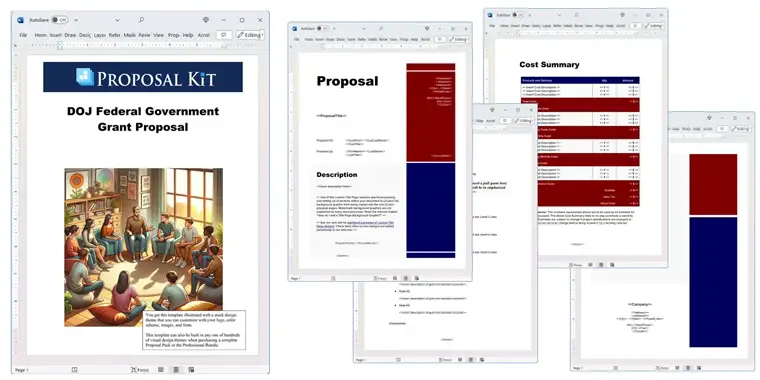How to write your DOJ Federal Government Grant Proposal
We include this 23 page layout with every Proposal Pack. If you want this template to have a different visual design theme than the one illustrated here, purchase any Proposal Pack design and create this template using the purchased design theme. This template is included in every Proposal Pack. If you get a Proposal Pack or the Professional Bundle, you can also make any variation of this template with different chapters to suit your needs.
We typically include more chapters in the templates than most people will need to give everyone more variety in the chapters they may need. You can trim down a long template by removing pages you do not need or combining multiple chapter topics into one page.
 DOWNLOADABLE, ONE-TIME COST, NO SUBSCRIPTION FEES
DOWNLOADABLE, ONE-TIME COST, NO SUBSCRIPTION FEES![]() View DOJ Federal Government Grant Proposal
View DOJ Federal Government Grant Proposal
This sample proposal is based on the same layout as this template and is included in every Proposal Pack. The visual design of the templates will match whichever Proposal Pack design you purchase. To get this template in a different design theme than shown in the sample, purchase any other Proposal Pack design theme and this template will be included.
You can create an editable Word version of this sample in any design theme of your choice including branded to your logo.
 If you need this template on DVD media order from our Amazon shop.
If you need this template on DVD media order from our Amazon shop.
You can also create countless variations of this document to suit your needs using the included library of 2200+ chapters if ordering a Proposal Pack or Pro Bundle.
 What Our Clients Say
What Our Clients SayGot a large deal with my first proposal using your system. Love it!"
Related Article
Related Video
Related Templates
- DOJ Federal Government Grant Proposal #2
- DOH Federal Government Grant Proposal
- HHS Federal Government Grant Proposal
- HHS Federal Government Grant Proposal #2
- DOE Federal Government Grant Proposal
- DOE Federal Government Grant Proposal #2
- EPA Federal Government Grant Proposal
- EPA Federal Government Grant Proposal #2
- USDA Federal Government Grant Proposal
- EPA Federal Government Grant Proposal 2
- DOJ Federal Government Grant Proposal 2
- HHS Federal Government Grant Proposal 2
What's the Best Way to Write Your DOJ Federal Government Grant Proposal?
Writing a DOJ federal government grant proposal can seem overwhelming. What is the best solution? Using the Proposal Kit template and software package. This comprehensive toolkit not only simplifies the proposal writing process but also ensures your submission is professional, thorough, and tailored to meet the specific requirements of a DOJ grant.
There are no one-size-fits-all or premade templates for responding to federal grant RFPs. Every grant has a unique set of requirements and instructions. They may or may not include forms, and the instructions might not tell you a specific layout. Usually, you have to read the RFP and piece together an outline yourself. This is where the Proposal Kit shines, as it is designed with a library of thousands of topics you can pick from that match what an RFP asks you to include. The Proposal Kit will build you a custom Word template to match the RFP instructions and will be ready for you to fill in the blanks.
If you find yourself tasked with writing a proposal for a DOJ grant, you're not alone. Many professionals in the criminal justice field face this challenge, often with tight deadlines and high stakes. Whether you're a small business owner, an employee in a company, or a director at a nonprofit, a well-written proposal is your key to securing funding.
What Types of Projects Are DOJ Federal Government Grant Proposals Written For?
The U.S. Department of Justice (DOJ) offers grants to support various projects to enhance the criminal justice system. These projects can vary significantly in scope and focus, reflecting the diverse needs across the country. Here are examples of projects that could be funded through DOJ federal government grants:
- Juvenile delinquency prevention programs
- Substance abuse treatment initiatives for offenders
- Community policing and crime prevention strategies
- Rehabilitation services for incarcerated individuals
- Legal aid services for underserved communities
- Domestic violence prevention and intervention programs
- Human trafficking victim support services
- Criminal justice system reform projects
- Technology upgrades for law enforcement agencies
- Training programs for criminal justice professionals
Chapters this template is built with
Proposal Kit templates and software are designed to streamline the writing process for DOJ federal government grant proposals. With thousands of customizable templates, including those for financial information and project planning, you can create a comprehensive and persuasive proposal. Here's how specific chapters from the Proposal Kit can aid in writing your proposal.
Each template is a Word document that can be edited and then saved as a PDF for submission, ensuring a professional and organized presentation of your proposal.
Cover Sheet
The Cover Sheet acts as the proposal's handshake, making the all-important first impression. It's more than just a title page; it briefly summarizes the proposal's content, including the project title, submission date, and contact information for both the submitter and the grant provider. This sheet sets the tone for the reader's expectations, emphasizing the proposal's professionalism and attention to detail.
Needs Assessment
The Needs Assessment serves as the foundation of the proposal, highlighting the specific needs of the community or system the project aims to address. This section requires thorough research and analysis to present a clear and compelling argument for why the project is necessary. It outlines the current challenges or gaps in services and directly explains how the proposed project will meet these needs.
Goals and Objectives
Goals and Objectives articulate what the project plans to achieve in a clear, measurable way. Goals are broad, overarching targets that reflect the project's end outcome, while objectives are specific, actionable steps that will be taken to reach these goals. This section is crucial for setting the project's direction and later evaluating its success.
Expected Results
Expected Results detail the positive changes or outcomes the project aims to bring about. This forward-looking section describes the tangible and intangible benefits of the project, such as improved community safety, reduced recidivism, or enhanced public health. It helps funders visualize the impact of their investment.
Activities
Activities list the specific actions or programs that will be implemented to achieve the project's goals. This section breaks down the project into its core components, detailing each activity's who, what, when, and how. It demonstrates the project's feasibility and the thoughtfulness of its planning process.
Design
The Design explains how the project will be structured and implemented, providing a blueprint for its execution. This includes methodologies, strategies, and the rationale behind chosen approaches. It's where the proposal spells out the logistics of turning ideas into action, ensuring the project is both practical and based on best practices.
Data Management
Data Management details how data will be collected, stored, and analyzed throughout the project. This section is crucial for projects requiring evidence-based outcomes, as it outlines the systems and processes that will ensure data integrity and security. It reassures funders that the project team can manage information effectively and use it to inform ongoing decisions.
Coordination
Coordination describes how the project will work with other organizations or agencies, highlighting partnerships and collaborative efforts. This section is essential for projects that involve multiple stakeholders, as it outlines the mechanisms for communication and cooperation. It reassures funders that the project is well-integrated into the broader ecosystem and can leverage external resources.
Project Management
Project Management outlines the management structure and responsibilities within the project. It details who will lead the project, the team's composition, and how tasks and responsibilities will be distributed. This section is critical to demonstrating the project's organizational capabilities and readiness to execute the proposed plan efficiently.
Time Line
The Time Line provides a schedule for project implementation and milestones. It offers a visual or descriptive timeline that maps out the project's key phases, activities, and deadlines, ensuring that the project is time-bound and its progress can be tracked against specific benchmarks.
Evaluation
Evaluation explains how the project's success will be measured, detailing the criteria, methods, and tools used to assess outcomes. This section is critical for demonstrating the project's commitment to accountability and continuous improvement, showing funders how their investment's effectiveness will be verified.
Performance Requirements
Performance Requirements detail the standards and targets the project must meet. This section sets specific expectations for project outcomes, aligning them with the goals and objectives previously outlined. It establishes benchmarks for success, helping to ensure that the project remains focused and high-performing.
Financial Information and Budget
Financial Information and Budget includes detailed cost summaries, budgets, and financial projections. This section provides a comprehensive breakdown of the project's economic needs, including direct and indirect costs, and how funds will be allocated. It demonstrates the project's financial viability and ensures transparency in how requested funds will be used.
Resume
The Resume section of a proposal showcases the qualifications, experiences, and competencies of key project personnel. This part is not just a collection of individual resumes but a strategic presentation of the team's expertise relevant to the project. It includes educational backgrounds, prior work experiences, specific skills, and achievements that underscore the team's capacity to deliver on the project's objectives. Highlighting the strengths of project leaders and critical staff, this section aims to build confidence in the project team's ability to execute the proposed plan effectively.
Constituency
The Constituency section delves into the demographic and geographic details of the population the project aims to serve. It outlines who will benefit from the project, describing the target audience's characteristics, needs, and how they were identified. This section is crucial for demonstrating the project's alignment with the needs of its intended beneficiaries and for showing an understanding of the community context. By providing a clear picture of the constituency, this part of the proposal ensures that the project's goals and activities are grounded in the real-world needs of those it seeks to impact.
Personnel
The Personnel section outlines the broader team beyond the key positions, detailing the roles, responsibilities, and qualifications of all staff members involved in the project. It may include the core project team and any support staff whose work will contribute to the project's success. This comprehensive overview ensures a clear understanding of the project's human resources and how each team member's work aligns with the project's objectives. By delineating the structure and capabilities of the entire team, this section demonstrates the project's operational capacity and readiness.
Key Positions
Key Positions are highlighted to emphasize the roles critical to the project's success, detailing the specific responsibilities, required qualifications, and the significance of each position to the project's objectives. This subsection often focuses on leadership roles such as the Project Manager, Lead Researcher, or Chief Financial Officer. Still, it can include other pivotal roles unique to the project's needs, such as technical experts or community liaisons. The purpose is to underscore the strategic importance of these positions in achieving the project goals and to demonstrate that the project has identified and allocated resources to secure the right talent for these roles.
Worksheet
The Worksheet section is a placeholder page for inserting forms and worksheets provided by the agency issuing the RFP instructions. You might add multiple Worksheet pages to your starting template. This can include detailed tables and spreadsheets that list specific tasks, assign responsibilities, set deadlines, and estimate costs.
Use cases for this template
A Small Business Triumph
Elena, the dynamic owner of Bright Future Counseling, faced the task of creating a proposal that stood out. Her goal was ambitious: to secure a government project to rehabilitate juvenile offenders through innovative counseling services. The competition was stiff, with numerous established companies vying for the same opportunity.
Undeterred, Elena turned to Proposal Kit, a decision that proved pivotal. With its user-friendly templates, she could break down her comprehensive plan into digestible sections, each meticulously outlining her business's unique approach. Elena emphasized evidence-based counseling techniques tailored to juvenile offenders, integrating technology to track progress and outcomes.
The expected outcomes section of her proposal was particularly compelling. Here, Elena detailed the transformative impact her services aimed to have on these young individuals' lives, including reduced recidivism rates and improved societal reintegration. She supported her claims with data and research, adding credibility to her ambitious goals.
The budget section was another area where Proposal Kit's templates shone. Elena provided a transparent, itemized budget that detailed costs while demonstrating value for money. This clarity and precision underscored her project's feasibility and her company's capability to manage funds efficiently.
When the award announcement came, Elena's proposal had succeeded. Her vision, articulated clearly and professionally through Proposal Kit's resources, resonated with the grant committee and had checked all the boxes in the instructions. Bright Future Counseling was set to embark on a project that could change many young lives, marking a significant triumph for Elena's small business.
Meeting the Boss's Expectations
Marco, a project manager at Justice Innovations, found himself in a race against time. The company had set its sights on a DOJ grant to fund a pioneering community policing initiative, and Marco was tasked with creating the proposal. The deadline was just weeks away, and the pressure was mounting.
Realizing the magnitude of the task, Marco integrated Proposal Kit's structured templates with the capabilities of an AI writing tool. This combination allowed him to efficiently tackle sections of the proposal, from outlining the innovative community policing strategies to defining the expected outcomes of the initiative. He utilized AI to generate coherent and deeply reflective content of Justice Innovations' mission, pulling in additional information and statistics from the company's website to enrich the proposal.
The timeline and project management sections were crucial. Marco detailed a clear, realistic implementation schedule complemented by a solid management plan that leveraged his team's strengths. This approach demonstrated the company's preparedness and capability to oversee such a significant project.
Marco's strategic use of technology and Proposal Kit resources paid off as the deadline approached. The completed proposal was submitted on time and is a testament to Marco's hard work and ingenuity. His boss was more than impressed, recognizing the effort and skill that went into meeting such a challenging deadline. When Justice Innovations was named a strong candidate for the grant, Marco's professional triumph affirmed his valuable contribution to the company's success.
A Nonprofit's Path to Funding
Sophia, the visionary director of Healing Paths Nonprofit, faced a pivotal moment. The organization, dedicated to substance abuse prevention, had the opportunity to expand its impact through a DOJ grant. The challenge? Writing a proposal that would capture the essence and ambition of their project.
With Proposal Kit as her guide, Sophia meticulously outlined her organization's plan. She began with a thorough needs assessment, leveraging local data to highlight the community's pressing need for substance abuse prevention programs. This section laid the groundwork, showcasing the project's relevance and urgency.
In the goals and objectives section, Sophia painted a picture of a community transformed by accessible, comprehensive substance abuse prevention services. She described a multifaceted approach that included education, support groups, and direct intervention services, each aimed at reducing substance abuse rates and fostering a healthier community.
The detailed budget section was a testament to Sophia's meticulous planning. Using Proposal Kit's templates, she outlined expected costs, from staffing to program materials, ensuring each dollar spent was accounted for and justified. This transparency and thoroughness demonstrated her nonprofit's accountability and commitment to fiscal responsibility.
When the grant was awarded to Healing Paths Nonprofit, it was more than a financial win; it validated Sophia's vision and her ability to convey it compellingly through her proposal. Thanks to Proposal Kit, she successfully navigated the complex grant application process, securing vital funding that would enable her organization to make a significant difference in the lives of those struggling with substance abuse.
Conclusions and Recommendations
Writing a DOJ federal government grant proposal is no small feat, but it becomes a manageable and even rewarding process with the right tools. Proposal Kit offers the resources and guidance needed to create a compelling proposal, whether you're improving the juvenile justice system, offering counseling services, or launching a new criminal justice initiative. If you're preparing a DOJ federal government grant proposal, consider Proposal Kit your pathway to achieving your project's goals.
Also Known As
This template may also be referred to in different ways or be used in more specialized situations, such as:
- DOJ Federal Funding Request
- Department of Justice Grant Application
- DOJ Financial Assistance Proposal
- Federal Justice Program Funding Request
- DOJ Grant Submission
- Department of Justice Funding Application
- DOJ Project Support Proposal
- Federal Justice Grant Proposal
- DOJ Program Funding Request
- Justice Department Grant Application
Abstract
 Creating a successful Department of Justice (DOJ) federal government grant proposal requires a thorough understanding of the justice programs and their key components. The Proposal Kit emerges as an invaluable tool, guiding applicants through the complex maze of DOJ solicitations, enabling them to develop submissions that align with the DOJ's funding priorities. This toolkit simplifies the process, providing customizable templates that reflect the unique requirements of each solicitation, from the Office on Violence Against Women (OVW) to community-oriented policing services (COPS).
Creating a successful Department of Justice (DOJ) federal government grant proposal requires a thorough understanding of the justice programs and their key components. The Proposal Kit emerges as an invaluable tool, guiding applicants through the complex maze of DOJ solicitations, enabling them to develop submissions that align with the DOJ's funding priorities. This toolkit simplifies the process, providing customizable templates that reflect the unique requirements of each solicitation, from the Office on Violence Against Women (OVW) to community-oriented policing services (COPS).
To secure grant opportunities, applicants must engage with the DOJ's JustGrants system, ensuring all application materials meet specific submission criteria. The Proposal Kit assists in creating professional proposals that include important sections like Needs Assessment, Goals and Objectives, and Financial Information. These topics are crucial for demonstrating the project's potential to pursue safe and healthy lives, enhancing public safety, and holding offenders accountable.
Furthermore, the proposal's design and Data Management strategies should reflect best practices, fostering trust in the project's implementation. Coordination with state agencies and local governments is often necessary, highlighting the importance of cooperative agreements and partnerships. Applicants must stay informed about DOJ solicitations, using JustGrants resources to navigate the procedural landscape.
 A robust DOJ proposal should address significant issues, outlining clear objectives and performance requirements. By adhering to federal leadership guidelines and respecting regulations, proposals can communicate their aim to provide victims with the necessary support and protection.
A robust DOJ proposal should address significant issues, outlining clear objectives and performance requirements. By adhering to federal leadership guidelines and respecting regulations, proposals can communicate their aim to provide victims with the necessary support and protection.
The Proposal Kit also ensures that the proposal's budget is comprehensive and clear, detailing expected costs and financial questions. This clarity is vital in demonstrating fiscal responsibility and the project's viability. By employing an approach and using Proposal Kit's structured guidance, applicants can submit well-rounded proposals that stand out in the competitive landscape.
Ultimately, creating a DOJ federal government grant proposal with the help of Proposal Kit allows applicants to transform their vision into actionable plans. Whether addressing community policing, juvenile justice, or technology upgrades for law enforcement, these proposals are crucial for securing DOJ funding and advancing justice programs across various jurisdictions.
 In preparing a comprehensive DOJ federal government grant proposal, it is important to navigate the justice grants system efficiently. Applicants are encouraged to register on the JustGrants portal, where they can find answers to general information and financial questions related to DOJ solicitations. By fully using JustGrants resources, applicants can ensure they meet all reporting requirements, thus enhancing their proposals' credibility.
In preparing a comprehensive DOJ federal government grant proposal, it is important to navigate the justice grants system efficiently. Applicants are encouraged to register on the JustGrants portal, where they can find answers to general information and financial questions related to DOJ solicitations. By fully using JustGrants resources, applicants can ensure they meet all reporting requirements, thus enhancing their proposals' credibility.
The Proposal Kit serves as a cornerstone, offering a structured approach to developing proposals that align with the DOJ's mission to promote safe and healthy lives through robust public safety initiatives. Whether addressing critical issues such as violence against women, juvenile delinquency prevention, or criminal justice system reform, a well-written proposal can significantly impact communities.
The COPS Office and Office of Justice Programs (OJP) are key components of the DOJ's grant-making initiatives. By submitting applications that reflect federal leadership standards, applicants can demonstrate their commitment to holding offenders accountable and providing victims with important protection. The Proposal Kit aids in structuring sections like Expected Results, which are vital for outlining the tangible benefits and transformative impact of proposed projects.
 Applicants must also be mindful of the importance of a clear Needs Assessment, highlighting the necessity of their projects within specific jurisdictions. This assessment should leverage data and research to outline existing challenges and gaps in services, thus emphasizing the project's relevance and urgency.
Applicants must also be mindful of the importance of a clear Needs Assessment, highlighting the necessity of their projects within specific jurisdictions. This assessment should leverage data and research to outline existing challenges and gaps in services, thus emphasizing the project's relevance and urgency.
In terms of project management, proposals should detail a clear timeline and allocate resources, showcasing the applicant's capability to manage the project from inception to completion. Key positions within the project team should be delineated, and personnel qualifications should be highlighted to build confidence in the project's potential success.
For state agencies and local governments seeking OJP funding, understanding the nuances of cooperative agreements and award recipient responsibilities is crucial. This involves not only complying with DOJ regulations but also fostering collaboration with other organizations to maximize the impact of justice programs.
 Finally, the Proposal Kit ensures that each proposal section, from budget justifications to evaluation plans, is developed. By addressing every topic of the DOJ's requirements, applicants can submit proposals that are both competitive and aligned with the broader objectives of the justice programs they aim to support.
Finally, the Proposal Kit ensures that each proposal section, from budget justifications to evaluation plans, is developed. By addressing every topic of the DOJ's requirements, applicants can submit proposals that are both competitive and aligned with the broader objectives of the justice programs they aim to support.
Frequently Asked Questions
What should be included in a DOJ Federal Government Grant Proposal?
A DOJ Federal Government Grant Proposal should include a cover letter, executive summary, problem statement, project description, budget justification, evaluation plan, sustainability plan, and relevant attachments like resumes and letters of support. What is included depends on the RFP instructions.
How do I ensure my proposal aligns with the DOJ's funding priorities and objectives?
To align your proposal with the DOJ's funding priorities, thoroughly review the Funding Opportunity Announcement (FOA), highlight how your project addresses these priorities, use relevant data to demonstrate need and impact, consult previous awards for guidance, and engage with stakeholders to ensure your project is comprehensive and aligned with the DOJ's interests.
What are the common mistakes to avoid when writing a DOJ grant proposal?
Common mistakes include missing submission deadlines, providing an unclear problem statement, setting vague objectives, offering poor budget justification, ignoring FOA guidelines, lacking collaboration with stakeholders, and presenting an insufficient evaluation plan. Avoiding these pitfalls enhances the clarity and competitiveness of your proposal.
How do I create a robust evaluation plan for my DOJ grant proposal?
A strong evaluation plan involves defining clear objectives, identifying qualitative and quantitative evaluation methods, specifying data collection techniques, outlining data analysis procedures, setting benchmarks and performance indicators, planning for reporting results, and including a timeline for evaluation activities. This ensures the project's impact can be effectively measured and reported.
What are the best practices for writing a compelling narrative for a DOJ grant proposal?
To write a compelling narrative, tell a clear and engaging story, avoid jargon, support your claims with data and evidence, highlight any innovative aspects of your project, demonstrate your organization's capacity to implement the project, engage stakeholders, and meticulously proofread and edit your proposal to ensure clarity and accuracy.
15% Off Discount
![]() Add To Cart This Word Template Only
Add To Cart This Word Template Only
 Add To Cart Proposal Pack for Government Grants
Add To Cart Proposal Pack for Government Grants
 Add To Cart Proposal Kit Professional Bundle
Add To Cart Proposal Kit Professional Bundle
 4.7 stars, based on 846 reviews
4.7 stars, based on 846 reviewsProposal Kit chapters used in this template
Cover Sheet, Title Page, Table of Contents, Needs Assessment, Goals and Objectives, Expected Results, Activities, Design, Data Management, Coordination, Project Management, Time Line, Evaluation, Performance Requirements, Financial Information, Budget, Project Budget, Resume, Constituency, Personnel, Key Positions, Worksheet, Back Page
Included Calculator Spreadheets
These Excel calculator spreadsheets are included with this template. If you purchase a Proposal Pack or the Professional Bundle, these proposal pages are generated using an automated line-item database in the included Wizard software. The calculator spreadsheets are intended for use when purchasing only the static Word template.
Time Line Calculator, Budget Three Year Calculator, Project Budget Calculator
You use this proposal for
- Non-technical proposal
- Service sales proposal
- Project pitch proposal
- RFP response
- Federal government grant proposal
How to create this template with Proposal Pack Wizard
You can create this document using any of the logo-designed Proposal Packs. Pick any Proposal Pack with a logo design theme you like best; they will all work equally well. The Proposal Pack for Any Business is the pack with no extra added logos or colors - designed to be used plain or for you to customize with your logos and graphics.
The Proposal Pack design theme you purchase will determine the visual look of this template. The screenshot above only shows the plain generic design theme. Names and stories in examples are fictional; however, the templates are from real client use cases.
We include a library of chapters to be assembled based on your needs. All proposals are different and have different needs and goals. We designed Proposal Pack so you can customize the documents to suit your needs.
You will best create this document using the Proposal Pack Wizard - Expert Edition software to select this template and build it in the Proposal Pack logo design theme of your choice along with any desired customizations (such as adding additional chapters, removing unneeded chapters, changing the order of chapters, and importing your company logo). This template outlines a proposal for the described situation. Each user is responsible for typing in the actual content of the provided pages with their information to complete the proposal. Suggestions in the abstract may include features in higher-end packages and are facilitated by the selection of chapter templates to support the narrative of each proposal, which help guide the user in filling in the details.
You create this template using the Wizard software with an entire Proposal Pack library and software. We include the Expert Edition of the software in the Proposal Kit Professional bundle. Microsoft Word for Windows is required to use the customizing software. You can also edit Word document templates in other office software such as Word for Mac. We will assist Mac users in assembling complex templates for their first project if they do not have the required platform to run the Wizard software.
You only get the single assembled Word document if purchased as a stand-alone template. The individual template products include no other templates, samples, or software.
How to Build Templates Featured on Proposal Kit Website
Many people find the Proposal Kit website after searching for a specific proposal. Once you've purchased and installed the software, how do you build that template you found in the first place? This video shows you how to build any proposal you see on the Proposal Kit website.
Key Takeaways
- The DOJ Federal Government Grant Proposal is available as a ready-to-edit template.
- You can create unlimited custom variations of this template using a Proposal Pack or the Professional Bundle.
- Using a Proposal Pack or Professional Bundle, you can automate quotes and other financial pages with a line-item database.
- There are no ongoing subscription fees. You get lifetime unlimited use.
- We made Proposal Kit for freelancers, small businesses, and non-profits.
- Proposal Kit product content (templates, samples, software) is 100% written by humans.
 Ian Lauder has been helping businesses write their proposals and contracts for two decades. Ian is the owner and founder of Proposal Kit, one of the original sources of business proposal and contract software products started in 1997.
Ian Lauder has been helping businesses write their proposals and contracts for two decades. Ian is the owner and founder of Proposal Kit, one of the original sources of business proposal and contract software products started in 1997.By Ian Lauder
 Published by Proposal Kit, Inc.
Published by Proposal Kit, Inc.


 Cart
Cart


 Get 15% off ordering today:
Get 15% off ordering today: 

 Facebook
Facebook YouTube
YouTube X
X Search Site
Search Site